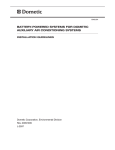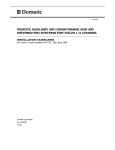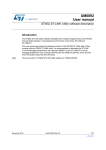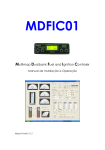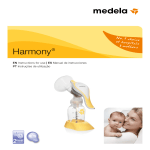Download Dometic 2597 Specifications
Transcript
Dometic Environmental Corporation P.O. Box 15299 I Richmond, VA 23227 USA I 804-746-1313 I Fax 804-746-7248 www.dometictruck.com I [email protected] UNITED STATES & CANADA SERVICE ONLY Weekdays 8:00 am to 5:00 pm (Eastern Time) 804-746-1313 All other times 888-440-4494 ID: 2597 Rev. 20080408 For all other areas visit our website to find your nearest distributor. ENGLISH BATTERY-POWERED SYSTEMS FOR DOMETIC AUXILIARY AIR CONDITIONING SYSTEMS INSTALLATION GUIDELINES Dometic Environmental Corporation Rev. 20080408 ID: 2597 COPYRIGHT © 2008 Dometic Environmental Corporation, All Rights Reserved. No part of this publication may be reproduced, translated, stored in a retrieval system, or transmitted in any form or by any means electronic, mechanical, photocopying, recording or otherwise without prior written consent by Dometic Environmental Corporation. Every precaution has been taken in the preparation of this manual to insure its accuracy. However, Dometic Environmental Corporation assumes no responsibility for errors and omission. Neither is any liability assumed for damages resulting from the use of this product and information contained herein. 2 ENGLISH Battery-Powered Systems Installation Guidelines Contents Notes and Warnings 4 Installing the Batteries 5 Installing Additional Battery Boxes 6 Wiring the New Batteries 6 Installing the Battery Fuel Gauge 7 Installing the Inverter 7 Optional: Installing the Inverter/Charger 7 Installing the Inverter Controls 8 Installing the Alternator 9 Installing the Regulator 10 – 11 Testing the Alternator 12 Wiring the 120VAC Power to the HVAC Unit 12 Optional: Installing 120VAC Outlets inside the Sleeper 13 Optional: Installing Shorepower Connection 13 Wiring Diagrams for Battery Connection Configurations ENGLISH 14 – 19 3 Battery-Powered Systems Installation Guidelines NOTES AND WARNINGS IMPORTANT The Dometic battery-powered air conditioning system is an integrated package of components which have been carefully selected and tested to work together for proper performance. The system includes: • Inverter (or optional inverter with built-in charger) • High-capacity alternator with external regulator • AGM Group 31 batteries • Shorepower connection (optional) • Inside AC power plugs (optional) • Dometic air conditioning units with digital controls Do not substitute any other components than those specified by Dometic. Using non-standard components may not provide the performance specified by Dometic and may void your warranty for the air conditioning system. Before you starT • R ealize that all the manuals are written to inform an installer that is skilled in mechanical areas, such as alternators, batteries, and cabling, as well as skilled in HVAC and electrical areas. If you have any questions after reading this and all manuals that accompany the individual parts, please call 804-746-1313, and ask for the Dometic Truck Applications Department. • O pen all boxes and check conditions of parts. If parts are damaged, please file the appropriate forms with the shipping company. If parts are missing, please contact Dometic. • Refer to Technology and Maintenance Council (TMC) RP160 for guidelines on inverter wiring. • Realize that all parts required may not necessarily be included, such as: • Battery cables • Cable secondary protection (wire loom) • Some fasteners (i.e., wire ties) • A ll tools (i.e., frame drill, bits, wrenches, drills, hole saws) (Note that it is highly recommended that the called-out tools be used when called for) • General shop supplies Getting the materials together • Open all boxes and lay out materials in areas with parts that will be used for the same type of system. Tools that may be required • See each individual manual for a list of the tools required. 4 ENGLISH Battery-Powered Systems Installation Guidelines Installing the Batteries You will replace the standard lead-acid batteries with absorbed glass mat (AGM) batteries (Fig. 1) and also add extra AGM batteries to get extended time running on battery power. The first step is to find space for the extra batteries and inverter. Note that whenever possible the inverter should be mounted in the same box with the batteries. Available space will vary based on the truck specifications, such as frame length, fuel tank length and empty tool boxes already on the truck. If additional boxes are included in your kit, you will need to mount them firmly to the frame of the truck. This may require that some slight adjustments be made to fuel tank placement. Be creative, however, always be cautious, as any changes you make could cause problems elsewhere. Figure 1 – AGM batteries replace standard lead-acid batteries If you choose to use boxes already installed on the truck for additional batteries make sure they are rated for the weight of the batteries and inverter. Never disregard OEM suggestions relating to frame welding and drilling, as they are very important. Consider center-mount battery boxes (Fig. 2). Freightliner and Volvo offer center-mount boxes that offer four battery spaces. If a center-mount box is not available, consider side frame mounted boxes from the truck manufacturer. Dometic offers a range of prewired battery boxes designed to fit on the side frame. ENGLISH Figure 2 – Center-mount battery box 5 Battery-Powered Systems Installation Guidelines Installing Additional Battery Boxes Boxes should be mounted with cabling in mind. The shorter the cables the less voltage drop and the less chance for chafing and rubbing. Mount Dometic battery boxes with four bolts, either supplied with the box, or Grade 8 fasteners of at least 5/8" diameter. The final strength of the bolting solution on the frame rests with the installer. Washers on both sides with a locking nut (ny-lock, tri-lobe or stover) are suggested. Lock washers are not recommended. Torque 5/8" bolts to 140-155 ft-lbs. Torque 3/4" bolts to 260-280 ft-lbs. Drill the frame for at least four bolts in the vertical section (web). Most OEMs do not allow drilling in the horizontal sections. Most OEMs also do not allow welding or torching frames. Please be sure that whatever you do meets OEM requirements, so as not to void any warranties. Wiring the New Batteries Before installing any batteries, load test each one. One bad battery can ruin the entire bank. And yes, sometimes brand new batteries can be bad. Batteries can be wired in one of two methods: A dualbank system (house and starting), and a single-bank system. The dual-bank system provides redundancy, while the single-bank system provides for less total weight, complexity and number of batteries. Use the wiring diagrams at the back of the manual for different wiring configurations (Fig. 3). Conductors between each battery should be of the same size as conductors between each bank. We normally recommend at least 2/0 gauge. Conductors should be as short as possible and should be routed and clipped securely so as to prevent chafing and rubbing. Secondary chafe protection (wire loom) is recommended on AT LEAST the positive conductors between banks. It is also recommended that chafe protection be placed in chafe-prone areas on the negative wire. If you make your own cables, either crimp the end on the cable with the correct tool or solder it on. There are cable ends available with the solder already in the end. Either way, it is suggested that the connection be covered with heavy-duty heat shrink. This helps to prevent corrosives from being wicked up into the copper strands, where they can cause hidden corrosion. Application of corrosion reducers on the battery connections are not required when using AGM batteries, however, it will not hurt. Before and during connection of battery terminals, apply a light coating of the supplied dielectric grease (in the small clear packet) to every connection. This will help keep corrosion and voltage drop to a minimum. Replace the hex or wing nuts on the batteries with the supplied locking hex nuts. These will help keep the connections tight over the long haul. Tight connections will ensure less voltage drop. Figure 3 – Batteries connected 6 ENGLISH Battery-Powered Systems Installation Guidelines Installing the Battery Fuel Gauge Installing the Inverter Follow the manufacturer’s instructions to install the battery fuel gauge. Follow the manufacturer’s instructions. Here are some other suggestions: The shunt must be connected between the last battery and the inverter negative post. You may install the shunt at the battery or at the inverter. The aluminum bar may be moved to accommodate either. The inverter should be installed in the same box as the batteries, so as to keep the cable lengths short, reducing voltage drop to a minimum. Make sure that you attach the shunt with the polarity correct by following the labels marked “Load” and “Battery.” Attach the small red wires to the positive battery post. If the cables need to be extended, use conductors of the same size. Connections that are outside should be at least butt-connected and covered in outsiderated shrink tube. Waterproof plugs are also a good method. The battery fuel gauge display should be mounted in an easily accessible place, probably the same area in which you will mount the HVAC or inverter controls. Consider first the area at the head of the bed (driver’s side of the truck). Usually the truck’s HVAC controls are mounted here and provide a wire chase for your use. Make sure to ground the chassis of the inverter to the chassis of the truck. Note that 12-gauge wire is acceptable for this requirement. Install the Dometic 200 amp circuit breaker or a properly-sized fuse in the positive cable between the last battery and the inverter. Optional: Installing the Inverter/Charger The inverter/charger and controls will be installed in the same manner as the inverter (Fig. 4). However, the inverter/charger will be connected to the shorepower connection (to be discussed later in this manual). The fuel gauge requires a hole size of a standard round truck gauge. A hole saw of 2 1/8” gives the correct mounting hole. Figure 4 – Inverter/Charger installed ENGLISH 7 Battery-Powered Systems Installation Guidelines Installing the Inverter Controls The inverter controls should be mounted in an easily accessible place, probably the same area in which you will mount the HVAC controls (Fig. 5). Consider first the area at the head of the bed (driver’s side of the truck). Usually the truck’s HVAC controls are mounted here and provide a wire chase for your use. Inverter control If you are installing in a day cab, and the inverter controls consist of a switch that measures 3/4" x 1 1/2", then you can remove the switch from the panel and install it into an empty dash switch location. If the cables need to be extended, use conductors of the same size. Connections that are outside should be at least butt-connected and covered in outside-rated shrink tube. Waterproof plugs are also a good method. 8 Figure 5 – Inverter control installed ENGLISH Battery-Powered Systems Installation Guidelines Installing the Alternator Follow the instruction manual included with the alternator/regulator. Here are a few additional tips. The new alternator should directly replace the existing one (Fig. 6) (i.e., pad mount or J180 mount). If not, you need to request the correct model. The alternator amp rating is based on the number of batteries in your system and may be different on different applications. You will have to reuse the alternator pulley. Alternator power wiring may have to be upsized or paralleled with an additional cable if the OEM cable size is not able to conduct the required current. Refer to the alternator literature for guidance. Figure 6 – Alternator installed The negative cable must be attached to the negative terminal on the alternator and the negative terminal on a battery. It must not go just to chassis ground. Secondary chafe protection (wire loom) is recommended on AT LEAST the positive conductor. It is also recommended that chafe protection be placed in chafe-prone areas on the negative wire. If you make your own cables, either crimp the end on the cable with the correct tool or solder it on. There are cable ends available with the solder already in the end. Either way, it is suggested that the connection be covered with heavy-duty heat shrink. This helps to prevent corrosives from being wicked up into the copper strands where they can cause hidden corrosion. Make double sure that all connections are tight, as loose connections can cause the regulator not to work correctly. ENGLISH 9 Battery-Powered Systems Installation Guidelines Installing the Regulator Follow the instruction manual included with the alternator/regulator. Here are a few additional tips. Mount the regulator inside the truck (Fig. 7), in an accessible area, so that the LED display can be seen. The wiring harness has two main separate harnesses. One goes to the battery box and one to the alternator. Follow the wiring directions included. Only one of the wires marked “Ignition” will be used. Use whichever lead is most convenient. The two wires with blue butt-connectors and heat shrink will not be used. Secure the relay and fuse holders using a mounting screw or a cable tie. A connection wire is required from the “F-” post on top of the alternator to the “Negative” connection on the back of the alternator. This wire may not be provided; and should be made with at least 14-gauge wire. Route and clip wires safely to prevent chafing. • If your existing alternator has a “Sense” wire attached, you will need to add a relay to make the “Alternator” or “Charge” dash light work correctly. See drawing “Charge Light Circuit for Alternators” below. The relay required is a small flange-mount 12VAC relay, like Song Chaun #792H, Tyco #V23234A0001X036 or Bosch #0 332 209 150. 10 Figure 7 – Regulator mounted inside truck ENGLISH Battery-Powered Systems Installation Guidelines Charge light circuIT for alternators with integral (Built-In) regulators Negative Ground Circuit 12 volts, 1 amp, D.C., Single Pole, normally closed contacts, insulated coil ENGLISH 11 Battery-Powered Systems Installation Guidelines Testing the Alternator Follow the manufacturer’s recommendations to test the alternator and regulator functions. Instructions are in the regulator manual. You will need a volt meter. There is a small door on the regulator. Remove the screw and twist the door to see the display. Wiring the 120VAC Power to the HVAC Unit Follow the directions and wiring diagrams in your air conditioner installation manual. The connection of the 120VAC cable to the inverter should be done with either the extension cable or the Y-cable assembly. Dielectric grease should be applied to any connections outside of the cab structure. “Splicing” outside of the cab without taking precautions for waterproofing is not permissible and may void your warranty. Only as many extensions as required should be used. Cables should be routed and clipped securely so as to prevent chafing and rubbing. The connection at the HVAC unit should be done with the supplied plug. 12 ENGLISH Battery-Powered Systems Installation Guidelines Optional: Installing 120VAC Outlets inside the Sleeper If so equipped, the system will have 120VAC outlets that can be installed inside the sleeper for accessory use. The outlets may be installed anywhere inside the sleeper, however, they should be installed in an area that makes sense for the loads the driver will be applying (i.e., probably near one cabinet or the other). The outlets should be installed with the Y-cable connection to the main cable between the inverter and the HVAC unit. Figure 8 – Shorepower connection installed Optional: Installing Shorepower Connection The shorepower connection is only available with the inverter/charger. The shorepower connection should be installed preferably on the driver’s side of the truck. If the driver’s side of the truck is not in reach of the battery box in which the inverter/charger is mounted, then the connection should be installed as close to the inverter/charger as possible (Fig. 8). This will probably be in the side of the battery box in which the inverter/ charger is mounted. ENGLISH 13 14 Alternator + - Battery 1 AC Wiring DC Wiring + Battery 2 - + Battery 3 Overcurrent Protector + Inverter 120VAC Line - 4) Cable size should be chosen based on voltage drop and load. Cable to inverter should be 2/0 gauge or greater. All cables should have an ampacity rating of greater than the expected amp flow and/or the overcurrent protection device. 3) Inverter must be of approved type by Dometic in order to insure proper operation of system. 2) Alternator should be upgraded. Discuss with Dometic Applications Department for recommendation. 1) Batteries must be of the AGM dual purpose deep cycle/starting type. NOTES: HVAC Unit Battery-Powered Systems Installation Guidelines HVAC System Powered by Inverter and Multiple Starting/Deep Cycle Batteries ENGLISH ENGLISH - Start Battery 1 + 4) Cable size should be chosen based on voltage drop and load. Cable to inverter should be 2/0 gauge or greater. All cables should have an ampacity rating of greater than the expected amp flow and/or the overcurrent protection device. - House Battery 1 2) Alternator should be upgraded. Discuss with Dometic Applications Department for recommendation. + Battery Separator + 3) Inverter must be of approved type by Dometic in order to insure proper operation of system. + Start Battery 2 - Inverter 120VAC Line 1) House batteries must be of the AGM dual purpose deep cycle/starting type. NOTES: Alternator AC Wiring DC Wiring - + House Battery 2 HVAC Unit - House Battery 3 + - House Battery 4 + Overcurrent Protection Battery-Powered Systems Installation Guidelines HVAC System Powered by Inverter and separate battery banks with battERY separator 15 16 + + - House Battery 1 4) Cable size should be chosen based on voltage drop and load. Cable to inverter should be 2/0 gauge or greater. All cables should have an ampacity rating of greater than the expected amp flow and/or the overcurrent protection device. - Battery Separator - 2) Alternator should be upgraded. Discuss with Dometic Applications Department for recommendation. + Start Battery 2 Y-Cord Splitter 3) Inverter must be of approved type by Dometic in order to insure proper operation of system. - Start Battery 1 Cab Power Outlets 120VAC Line 1) House batteries must be of the AGM dual purpose deep cycle/starting type. NOTES: Alternator AC Wiring DC Wiring + Shorepower Inlet - House Battery 2 + - House Battery 3 + - + Overcurrent Protection House Battery 4 Inverter with Shorepower Pass-Thru Capability OR Inverter/Charger HVAC Unit Battery-Powered Systems Installation Guidelines HVAC System Powered by Inverter and separate battery banks with separator Shorepower and cab power outlets ENGLISH ENGLISH + - House Battery 1 4) Cable size should be chosen based on voltage drop and load. Cable to inverter should be 2/0 gauge or greater. All cables should have an ampacity rating of greater than the expected amp flow and/or the overcurrent protection device. - Battery Separator + 2) Alternator should be upgraded. Discuss with Dometic Applications Department for recommendation. + Start Battery 2 - 3) Inverter must be of approved type by Dometic in order to insure proper operation of system. - Start Battery 1 120VAC Line 1) House batteries must be of the AGM dual purpose deep cycle/starting type. NOTES: Alternator AC Wiring DC Wiring + Shorepower Inlet - House Battery 2 + - House Battery 3 + - + Overcurrent Protection House Battery 4 Inverter with Shorepower Pass-Thru Capability OR Inverter/Charger HVAC Unit Battery-Powered Systems Installation Guidelines HVAC System Powered by Inverter and separate battery banks with separator shorepower capability 17 18 - + - + Battery 4 - Battery 5 + + Overcurrent Protection - Battery 6 4) Cable size should be chosen based on voltage drop and load. Cable to inverter should be 2/0 gauge or greater. All cables should have an ampacity rating of greater than the expected amp flow and/or the overcurrent protection device. + Battery 3 2) Alternator should be upgraded. Discuss with Dometic Applications Department for recommendation. - Battery 2 Y-Cord Splitter to GFCI Receptacle 3) Inverter must be of approved type by Dometic in order to insure proper operation of system. + Cab Power Outlet 120VAC Line 1) House batteries must be of the AGM dual purpose deep cycle/starting type. NOTES: - Battery 1 Alternator AC Wiring DC Wiring HVAC Unit + Inverter with Shorepower Pass-Thru Capability OR Inverter/Charger - Shorepower Inlet Battery-Powered Systems Installation Guidelines HVAC System Powered by Inverter - Single starting/house battery bank shorepower with cab power outlets ENGLISH ENGLISH - + - + - Battery 5 + + Overcurrent Protection - Battery 6 4) Cable size should be chosen based on voltage drop and load. Cable to inverter should be 2/0 gauge or greater. All cables should have an ampacity rating of greater than the expected amp flow and/or the overcurrent protection device. + Battery 4 2) Alternator should be upgraded. Discuss with Dometic Applications Department for recommendation. - Battery 3 3) Inverter must be of approved type by Dometic in order to insure proper operation of system. + Battery 2 120VAC Line 1) House batteries must be of the AGM dual purpose deep cycle/starting type. NOTES: - Battery 1 Alternator AC Wiring DC Wiring HVAC Unit + Inverter with Shorepower Pass-Thru Capability OR Inverter/Charger - Shorepower Inlet Battery-Powered Systems Installation Guidelines HVAC System Powered by Inverter - single starting/house battery bank shorepower capability 19




















